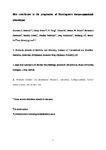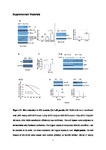Bim contributes to the progression of Huntington's disease-associated phenotypes
| dc.contributor.author | Roberts, SL | |
| dc.contributor.author | Evans, T | |
| dc.contributor.author | Yang, Y | |
| dc.contributor.author | Fu, Y | |
| dc.contributor.author | Button, RW | |
| dc.contributor.author | Sipthorpe, RJ | |
| dc.contributor.author | Cowan, K | |
| dc.contributor.author | Valionyte, E | |
| dc.contributor.author | Anichtchik, Oleg | |
| dc.contributor.author | Li, H | |
| dc.contributor.author | Lu, B | |
| dc.contributor.author | Luo, Shouqing | |
| dc.date.accessioned | 2019-12-14T17:41:45Z | |
| dc.date.issued | 2020-01-15 | |
| dc.identifier.issn | 0964-6906 | |
| dc.identifier.issn | 1460-2083 | |
| dc.identifier.uri | http://hdl.handle.net/10026.1/15251 | |
| dc.description.abstract |
<jats:title>Abstract</jats:title> <jats:p>Huntington’s disease (HD) is a neurodegenerative disorder caused by an expanded polyglutamine (polyQ) tract in the huntingtin (HTT) protein. Mutant HTT (mHTT) toxicity is caused by its aggregation/oligomerisation. The striatum is the most vulnerable region, although all brain regions undergo neuronal degeneration in the disease. Here we show that the levels of Bim, a BH3-only protein, are significantly increased in HD human post-mortem and HD mouse striata, correlating with neuronal death. Bim reduction ameliorates mHTT neurotoxicity in HD cells. In the HD mouse model, heterozygous Bim knockout significantly mitigates mHTT accumulation and neuronal death, ameliorating disease-associated phenotypes and lifespan. Therefore, Bim could contribute to the progression of HD.</jats:p> | |
| dc.format.extent | 216-227 | |
| dc.format.medium | ||
| dc.language | en | |
| dc.language.iso | en | |
| dc.publisher | Oxford University Press (OUP) | |
| dc.subject | Aged | |
| dc.subject | Animals | |
| dc.subject | Bcl-2-Like Protein 11 | |
| dc.subject | Corpus Striatum | |
| dc.subject | Disease Models, Animal | |
| dc.subject | Disease Progression | |
| dc.subject | Female | |
| dc.subject | Gene Knockout Techniques | |
| dc.subject | Heterozygote | |
| dc.subject | Humans | |
| dc.subject | Huntingtin Protein | |
| dc.subject | Huntington Disease | |
| dc.subject | Male | |
| dc.subject | Mice | |
| dc.subject | Middle Aged | |
| dc.subject | Neurons | |
| dc.subject | Phenotype | |
| dc.subject | Protein Aggregates | |
| dc.subject | RNA, Small Interfering | |
| dc.title | Bim contributes to the progression of Huntington's disease-associated phenotypes | |
| dc.type | journal-article | |
| dc.type | Journal Article | |
| dc.type | Research Support, Non-U.S. Gov't | |
| plymouth.author-url | https://www.webofscience.com/api/gateway?GWVersion=2&SrcApp=PARTNER_APP&SrcAuth=LinksAMR&KeyUT=WOS:000515111800004&DestLinkType=FullRecord&DestApp=ALL_WOS&UsrCustomerID=11bb513d99f797142bcfeffcc58ea008 | |
| plymouth.issue | 2 | |
| plymouth.volume | 29 | |
| plymouth.publication-status | Published | |
| plymouth.journal | Human Molecular Genetics | |
| dc.identifier.doi | 10.1093/hmg/ddz275 | |
| plymouth.organisational-group | /Plymouth | |
| plymouth.organisational-group | /Plymouth/Faculty of Health | |
| plymouth.organisational-group | /Plymouth/Faculty of Health/Peninsula Medical School | |
| plymouth.organisational-group | /Plymouth/REF 2021 Researchers by UoA | |
| plymouth.organisational-group | /Plymouth/REF 2021 Researchers by UoA/UoA01 Clinical Medicine | |
| plymouth.organisational-group | /Plymouth/REF 2021 Researchers by UoA/UoA01 Clinical Medicine/UoA01 Clinical Medicine | |
| plymouth.organisational-group | /Plymouth/Research Groups | |
| plymouth.organisational-group | /Plymouth/Research Groups/Institute of Translational and Stratified Medicine (ITSMED) | |
| plymouth.organisational-group | /Plymouth/Research Groups/Institute of Translational and Stratified Medicine (ITSMED)/CBR | |
| plymouth.organisational-group | /Plymouth/Users by role | |
| plymouth.organisational-group | /Plymouth/Users by role/Academics | |
| plymouth.organisational-group | /Plymouth/Users by role/Researchers in ResearchFish submission | |
| dc.publisher.place | England | |
| dcterms.dateAccepted | 2019-11-11 | |
| dc.rights.embargodate | 2020-12-8 | |
| dc.identifier.eissn | 1460-2083 | |
| dc.rights.embargoperiod | Not known | |
| rioxxterms.versionofrecord | 10.1093/hmg/ddz275 | |
| rioxxterms.licenseref.uri | http://www.rioxx.net/licenses/all-rights-reserved | |
| rioxxterms.type | Journal Article/Review | |
| plymouth.funder | Tackling autophagy and apoptosis for the potential therapy of Huntington's Disease::MRC | |
| plymouth.funder | Tackling autophagy and apoptosis for the potential therapy of Huntington's Disease::MRC |



